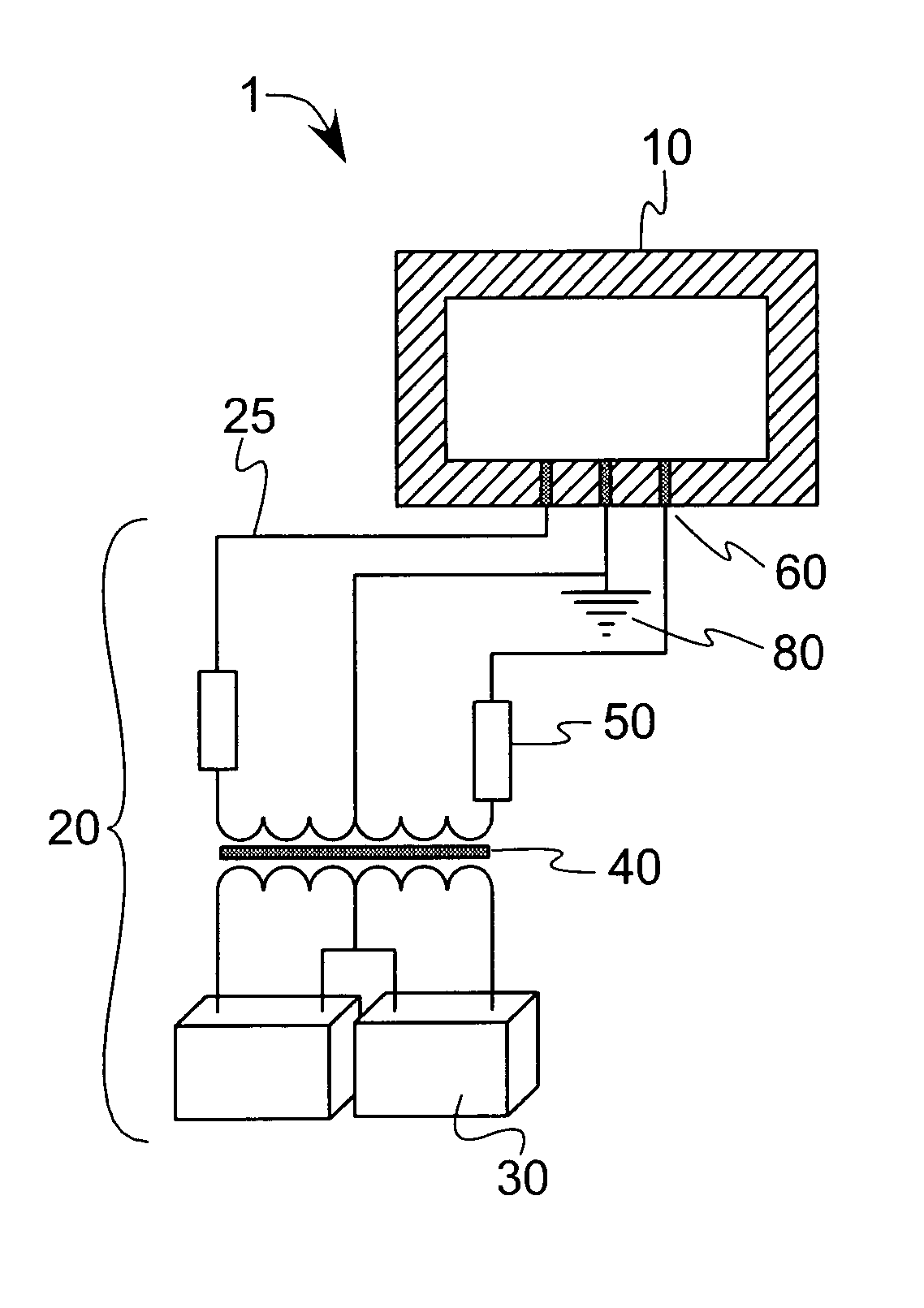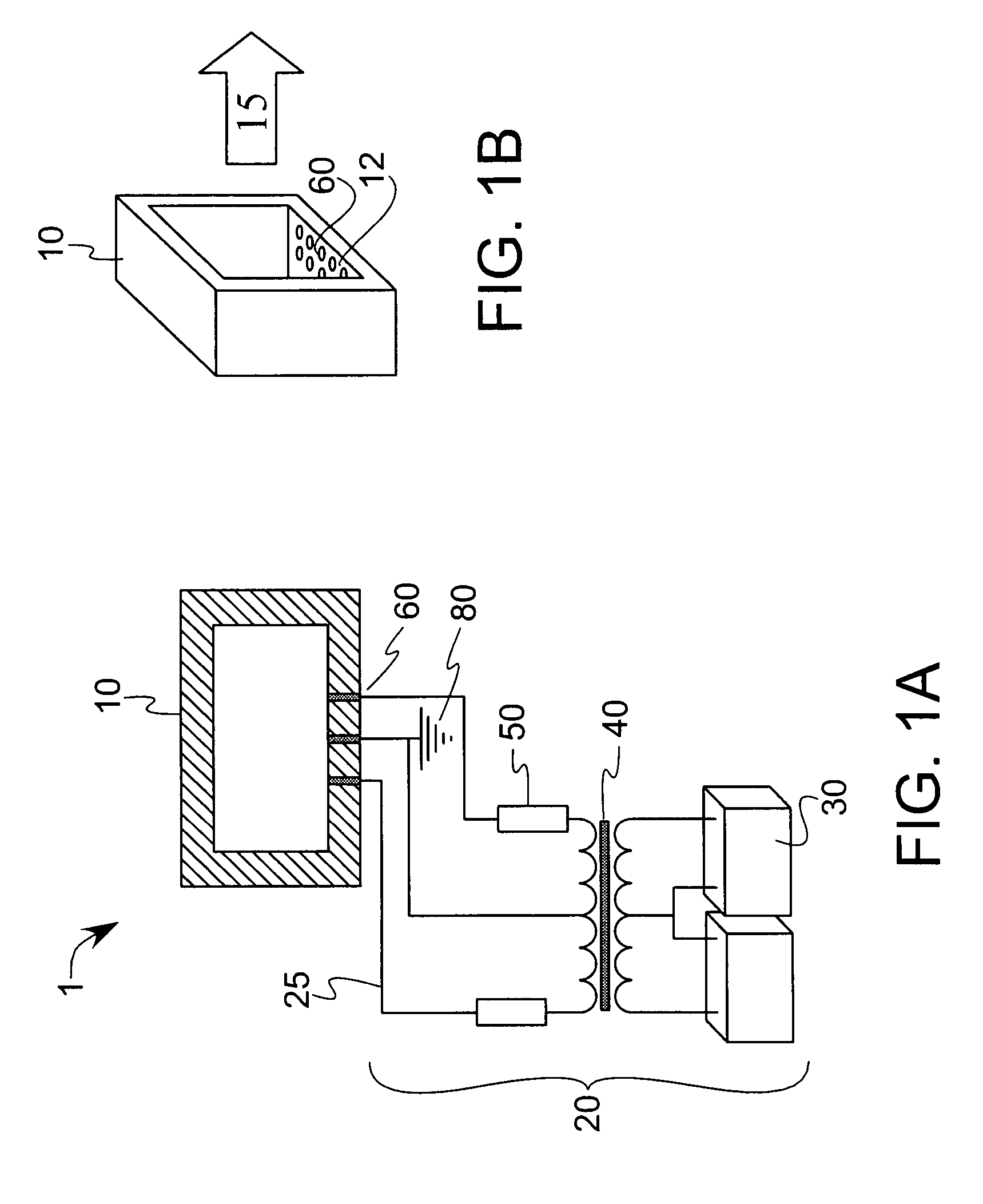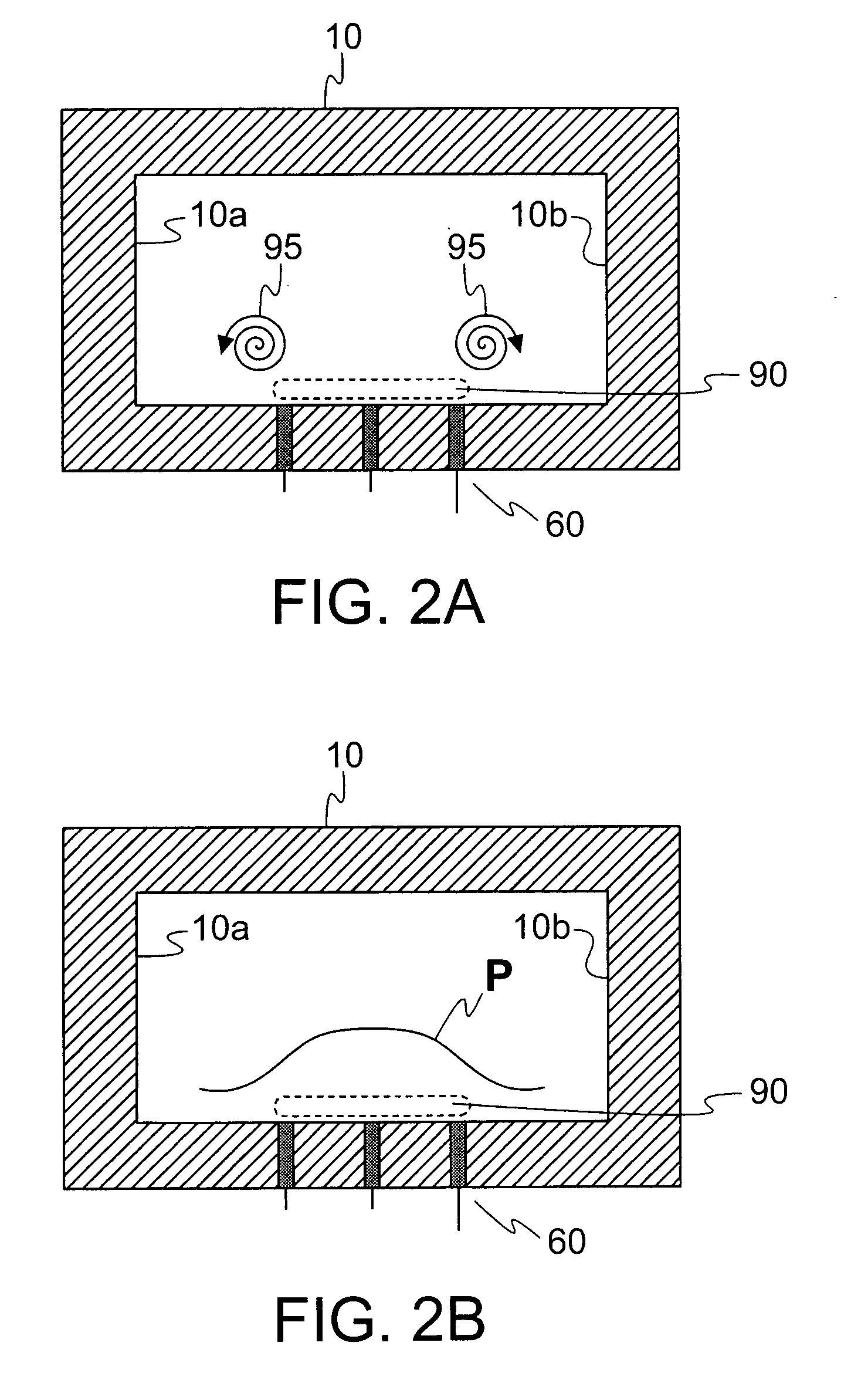[0012] These needs are met by the present invention, where one or more localized arc filament
plasma actuators (in the form of paired electrodes) include both
high amplitude and
high bandwidth without requiring the use of high-power pulsed lasers, focused
microwave beams, or electrodes protruding into the flow. The present inventors have discovered that the use of repetitively pulsed high-energy discharges emanating from electrodes spatially distributed on a conduit surface can produce streamwise vortices of desired distribution and kind. As previously mentioned, flow perturbations can produce spanwise vortices where, due to the nature of
jet flow, they are generated naturally by jet instabilities. Thus, while the inventors' intent focuses on the generation and use of streamwise vorticity, it will be appreciated by those skilled in the art that the production of spanwise vorticity could also have utility, and that the present invention could be adapted to enhance or weaken such spanwise vorticity, depending upon the application. The present invention can be configured to distribute electrodes and energize them with proper excitation frequencies in such a way as to influence shear layer instabilities.
[0013] The present inventors have discovered that the use of repetitively pulsed high-energy discharges can produce strong localized pressure perturbations in subsonic and supersonic flows, at static pressures of 1.0
atmosphere, with no fundamental limitations at higher or lower pressures. These localized pressure perturbations are hefty enough to effectively act like a physical obstacle (such as a flap, tab or the like) suddenly placed in the flowpath. In the present context, the term “localized” and its variants represent changes made in the area of the duct, conduit or related flowpath that is immediately adjacent the electrodes or related plasma-producing terminals. The proximity of the plasma to the
solid surface (i.e., the
nozzle wall) greatly improves plasma stability, reducing the chance of plasma being blown off by the incident high-speed gas (such as air or
exhaust gas) flow. Repetitive pulsing of the
discharge would enable control over these pressure perturbation obstacles by having an arc filament initiated in the flow generate rapid (on the time scale of down to a few microseconds) localized heating up to high temperatures, which produces a concomitant localized
pressure rise in the flow near the electrodes. Consequently, when the arc filament is on, the
electrode functions as the aforementioned physical obstacle, similar to a small tab inserted into the flow. Advantages associated with the present invention include: the ability of the electrodes to modify the flow field on-demand, thereby allowing the electrodes to be turned on and off to minimize
power consumption and potential losses when actuation is not necessary; avoidance of changing the geometry of the flowpath; avoidance of using
moving parts that can
wear out; and the controlling of mixing and noise in the jet by either excitation of flow instabilities, generating streamwise vorticity of desired frequency and strength, or by a combination of the two techniques.
[0015] According to a first aspect of the invention, a fluid
stream flow modification
system is disclosed. The system includes a fluid
stream conduit configured to receive flowing fluid from a fluid source, and an arc generator cooperative with the conduit such that upon system operation, an arc filament plasma is formed that produces a localized perturbation in a portion of the fluid
stream. The arc generator includes numerous electrodes disposed adjacent the fluid stream. The arrangement of the electrodes is such that they do not substantially protrude into the fluid stream, thereby by avoiding unnecessary flow disturbances. This unobtrusive profile, coupled with the on-demand nature of the flow perturbations, results in overall improvements in the flow of fluid in the stream. The electrodes produce localized (rather than global) perturbation that generates streamwise vorticity in the localized portion of the fluid stream. As previously mentioned, spanwise vortices are generated naturally by jet instabilities, and the present invention can be configured to enhance or weaken these spanwise vortices as needed. In addition to the electrodes, the system includes an
energy source that can impart enough energy to the electrodes such that an arc filament plasma capable of generating the localized perturbation is formed.
[0017] In another option, a controller can be coupled to the generator such that the generation of the localized perturbations at the electrodes occurs at predetermined times. For example, the electrodes can be energized either simultaneously or at staggered time intervals. Such staggering can promote the excitation of a desired
instability or related perturbation pattern. The resistance of the conduit to the
excess heat generated by the arc filaments can be made enhanced by various approaches. In one, the conduit can be made from a
refractory material, such as a
ceramic or
ceramic composite. In another, a
coolant supply can be placed in heat exchange relationship with the conduit to avoid excessive temperatures.
[0018] A
significant difference of the localized arc filament plasma electrodes of the present invention over plasma electrodes developed previously (such as surface
glow discharge-based devices) is that the present electrodes are designed to generate localized, high-temperature arc filaments rather than large surface area, low-temperature, non-equilibrium plasmas. Applying
high voltage of select frequency to the
electrode would generate a periodic arc and corresponding
Joule heat release, resulting in high-frequency excitation of the flow. In addition, using two or more properly phased electrodes at the same time would allow excitation of specific flow instabilities (for example, azimuthal
modes) by varying both the excitation frequency and the phase shift between individual electrodes. This effect, together with the small size of the filaments would make it possible to produce significant changes in the flow without a concomitant level of
power consumption. Thus, two of the electrodes can be configured to cooperate with each other to define an
actuator that produces the arc filament that in turn produces the localized perturbation. In a similar way, two (or more) electrodes could each be coupled to a ground
electrode to define the
actuator.
[0022] According to still another aspect of the invention, a method of reducing noise emanating form a flowpath is disclosed. The method includes flowing a fluid along the flowpath and generating an arc filament plasma at one or more locations along the flowpath to produce at least one localized perturbation in a portion of the flowpath, the localized perturbation configured such that upon its production, streamwise vorticity is formed in the portion of the flowpath.
 Login to View More
Login to View More  Login to View More
Login to View More 


